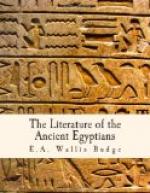As papyrus was expensive the pupils in the schools attached to the great temples of Egypt wrote their exercises and copies of standard literary compositions on slices of white limestone of fine texture, or upon boards, in the shape of modern slates used in schools, whitened with lime. The “copies” from which they worked were written by the teacher on limestone slabs of somewhat larger size. Copies of the texts that masons cut upon the walls of temples and other monuments were also written on slabs of this kind, and when figures of kings or gods were to be sculptured on the walls their proportions were indicated by perpendicular and horizontal lines drawn to scale. Portions of broken earthen-ware pots were also used for practising writing upon, and in the Ptolemaic and Roman Periods lists of goods, and business letters, and the receipts given by the tax-gatherers, were written upon potsherds. In still later times, when skin or parchment was as expensive as papyrus, the Copts, or Egyptian Christians, used slices of limestone and potsherds for drafts of portions of the Scriptures and letters in much the same way as did their ancestors.
A roll of papyrus when not in use was kept in shape by a string or piece of papyrus cord, which was tied in a bow; sometimes, especially in the case of legal documents, a clay seal bearing the owner’s name was stamped on the cord. Valuable rolls were kept in wooden cases or “book boxes,” which were deposited in a chamber or “house” set apart for the purpose, which was commonly called the “house of books,” i.e. the library. Having now described the principal writing materials used by the ancient Egyptians, we may pass on to consider briefly the various classes of Egyptian Literature that have come down to us.
CHAPTER II
THE PYRAMID TEXTS
“Pyramid Texts” is the name now commonly given to the long hieroglyphic inscriptions that are cut upon the walls of the chambers and corridors of five pyramids at Sakkarah. The oldest of them was built for Unas, a king of the fifth dynasty, and the four others were built for Teta, Pepi I, Merenra, and Pepi II, kings of the sixth dynasty. According to the calculation of Dr. Brugsch, they were all built between 3300 and 3150 B.C., but more recent theories assign them to a period about 700 years later. These Texts represent the oldest religious literature known to us, for they contain beliefs, dogmas, and ideas that must be thousands of years older than the period of the sixth dynasty when the bulk of them was drafted for the use of the masons who cut them inside the pyramids. It is probable that certain sections of them were composed by the priests for the benefit of the dead in very primitive times in Egypt, when the art of writing was unknown, and that they were repeated each time a king died. They were first learned by heart by the funerary priests, and then handed on from mouth to mouth, generation




